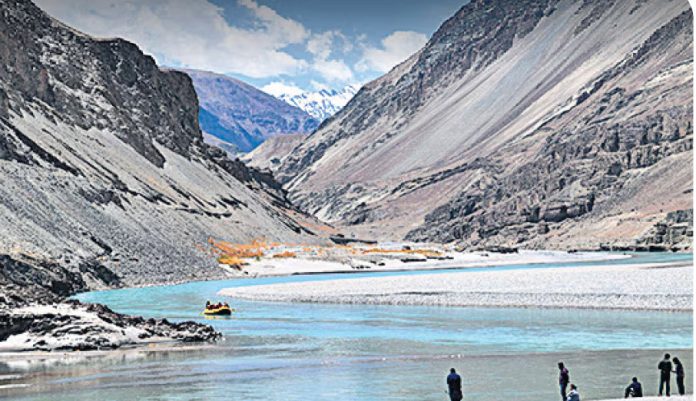Nawang Tsering Shakspo
To the surprise of all, the Central Government recently announced, in one stroke, five new districts for Ladakh, in addition to the existing two districts of Leh and Kargil. It was a historic decision as there was a hope only for only two new districts — Zanskar and Nubra. There wasn’t any persistent demand too for the creation of Drass, Sham and Changthang as separate districts.
Therefore, the BJP Government deserves a word of congratulation from the people of Ladakh, but on the day of declaration of the five new districts, one did not find much of jubilation among the people in Leh town, though it was natural for the BJP workers to celebrate the occasion.
Here, it is important to mention that before the year 1979, the Ladakh region had only one district with its headquarters in Leh. Later, to meet the aspirations of the people of Kargil, the Sheikh Abdullah Government bifurcated Ladakh into two – Leh and Kargil. With that Zanskar was granted special Sub-Divisional status within the dominion of Kargil district. Prior to that, Zanskar was provided with a post of revenue officer called Tehsildar to administrate the region as the area would stay disconnected with the rest of Ladakh for five to six winter months.
Now with the grant of five more districts, the question arises: What will be the shape and scope of the newly-created districts. Will these five districts have autonomous hill development councils like the Autonomous Hill Development Councils, Leh and Kargil; or will they be subsidiary districts by providing a Deputy Commissioner and a Superintendent of Police. This sort of hard questions and hard talk will emerge in the coming months as the Government of India has given three months to the U.T administration to sort out the administrative implications and frame the modalities including creation of posts and location of the headquarters of respective districts including involvement of expenses.
Needless to mention that Ladakh is a sparsely-populated region, the main reasons being harsh climatic conditions and bare mountains and deserts. Over the years, the Government poured in sufficient funds to uplift the living standards of the people of the region, but due to scanty Government job opportunities for the educated or the semi-educated youth of backward pocket of the region, they could not compete with the job seekers belonging to the other parts of the region where there are better facilities for studies and coaching etc. Due to the fact that the population of the border areas of Leh are shrinking day- by- day and the people are migrating to the affluent towns like Leh. This situation affects the environment of Leh, and its residents are facing many complications due to environmental hazards and traffic jams.
Within a two-and-half decades time, a sea change has come into the functioning of the administration of Ladakh. After struggle for more than half-a-century of Independence, two Ladakh Autonomous Hill Development Councils — Leh and Kargil were created in the year 1995. Though the Government granted LAHDC, headed by a Chief Executive Councilor and four Executive Councilors, unfortunately the Government did not create an appreciable number of posts in the Government departments. Hence, dissatisfaction came among the people. As such, people started demanding separate revenue or administrative division called Ladakh Division.
On the popular demand of the people of Jammu, Kashmir and Ladakh, the Government of India constituted a three-member interlocutor to study the administrative grievances of the people and finally a verdict came in the report of the interlocutor that Ladakh should be separated from the Kashmir Division and be made a separate Division. But no headway was there towards that direction. In this connection, I myself being an experienced retired Government official, took the issue to make Ladakh a separate Division putting my best possible efforts. I, as a humble citizen, raised the issue of granting Division status to Ladakh in the bi-annual colloquium of International Association of Ladakh Studies, held at Heidelberg in Germany in the year 2013; and subsequently my writings were published in the prestigious daily newspapers such as Daily Excelsior, Jammu, Greater Kashmir, Srinagar and Kashmir Times, Srinagar/Jammu. With the passage of time, the Government of India granted Divisional status to Ladakh in the year 2019. A process of declaration of Ladakh Division was in motion, yet another resolution from the Government of India came declaring Ladakh a Union Territory in the year 2019.
Today, Ladakh is passing through multiple administrative and political upheavals. I do not see the creation of five more district will satisfy the people of Ladakh or the Leh Apex Body and the Kargil Democratic Alliance, that are spearheading agitation and hunger strikes for the grant of Statehood to Ladakh or Constitutional Safeguard under the Sixth Schedule, two Lok Sabha and one Rajya Sabha seats for Ladakh, and filling up of 10,000 to 12, 000 vacancies in the Government departments.
I see no reason why the Government of India would consider granting Statehood to Ladakh as there are already 10 Councilors in the Autonomous Councils of Leh and Kargil who enjoy ministerial status, drawing all the facilities which are applicable to a minister of a State.
But what is the problem that the Government of India sees if Ladakh is brought under the purview of Sixth Schedule of the Indian Constitution?
I must say that the people of Ladakh are more loyal citizens than any other in the country for the unity and integrity of the country.
(The author is Director, Centre for Research on Ladakh Ayu-Saboo, UT, Ladakh)
Trending Now
E-Paper


